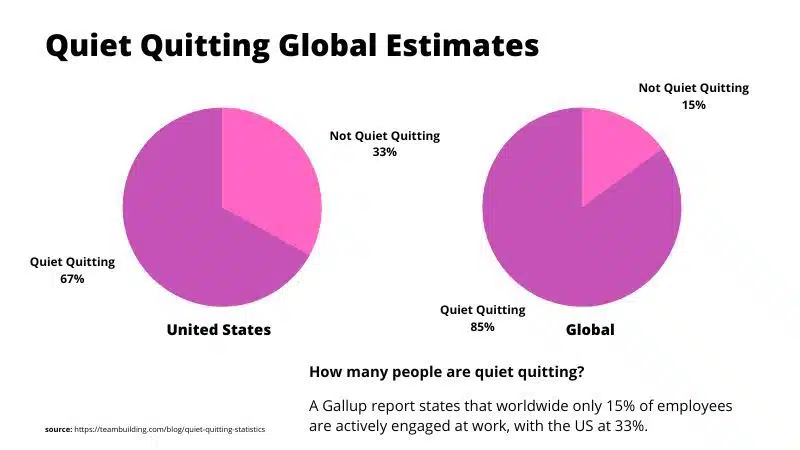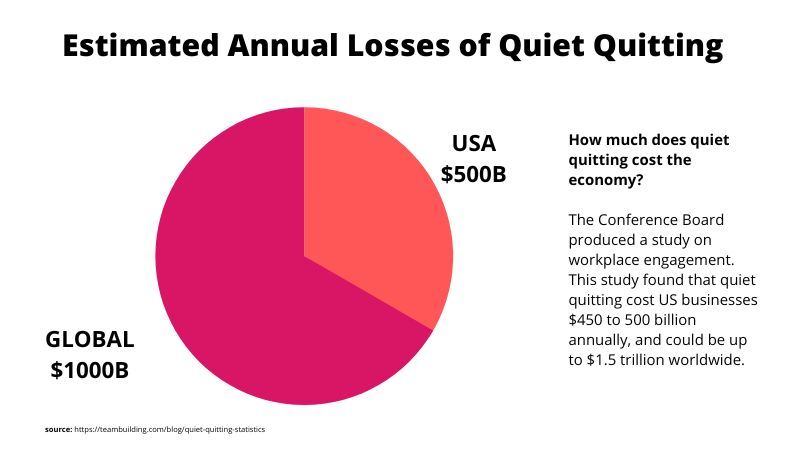You found our list of quiet quitting statistics.
Quiet quitting statistics are data and facts related to the quiet quitting trend. For example, how many employees are quiet quitting and what percentage of companies are investigating it. The purpose of this data is inform audiences and support journalistic narratives.
This data is related to quiet quitting and is similar to employee turnover statistics, employee engagement statistics and job satisfaction statistics.
This page includes:
- quiet quitting stats
- quiet quitting data
- quiet quitting infographics
Here are the facts.
List of quiet quitting statistics [free to cite]
You can use this data in any format, including social media, blogs, and presentations.
Please cite the source as TeamBuilding and link to https://teambuilding.com/blog/quiet-quitting-statistics.
1. Up to 67% of US employees and 85% worldwide could be quiet quitting

A Gallup report states that only 15 percent of employees are actively engaged at work, which means up to 85% could be quiet quitting. The numbers are a little better for the US, with 33% of employees engaged at work, approximately twice the worldwide average.
Perhaps surprisingly, the rate of employee engagement in Western Europe is very low, at 10% and only 8% in the United Kingdom. All of these numbers have been on a steady decline over the last decade.
2. USA is #2 in the world for quiet quitting activity

With the US as a baseline, here is how other countries deviate:
- Canada: 2% higher
- Australia: 14% lower
- New Zealand: 19% lower
- Singapore: 19% lower
- Luxembourg: 31% lower
- Ireland: 49% lower
- Finland: 62% lower
- Philippines: 64% lower
- China: 70% lower
There are possible explanations for these data trends around work culture, employee benefits, social security, work-life balance and more.
Get our free team building toolbox
- icebreaker games
- bingo cards
- DIY guides
 by teams at FedEx, Amazon, Deloitte and 73,930+ others
by teams at FedEx, Amazon, Deloitte and 73,930+ others

3. Quiet quitting leads to worldwide company losses of up to $1.5 trillion each year

The Conference Board produced a study on workplace engagement. This study found that quiet quitting cost US businesses $450 to 500 billion annually, and could be up to $1.5 trillion worldwide.
4. 79% of employees report they would stop quiet quitting if given more recognition
These stats on employee engagement from Octanner show that employees expect acknowledgment or recognition for their efforts after completing a project. Of these employees, 79% state that more recognition by managers and leaders would result in higher engagement and job performance.
5. In the US, 47% of employees just want to make ends meet
A report on workplace data by Pew Research shows that 47% or nearly half of all US employees believe that work is just way to pay the bills. This number would correlate with quiet quitting, since a lack of purpose or motivation at work is aligned with decreased engagement and productivity.
6. 73% of US employees are considering resignation
Up to 73 percent of US workers are considering leaving their jobs, which is data that closely correlates with quiet quitting.
The primary motivation for switching jobs is money. Nearly 74% of Millennial and Gen-Z employees would take a pay cut to work at their dream workplace.
7. The #quietquitting topic on LinkedIn has 461 followers
With all the discussion of quiet quitting, there is a relatively low number of people following #quietquitting on LinkedIn. This number is increasing by about 50 people per day.
How to cite these quiet quitting statistics
If you use data or statistics from this resource or re-share the infographic, please include a link to https://teambuilding.com/blog/quiet-quitting.
We will continue updating this resource with useful quiet quitting statistics, facts, and trends.
Next, check out this list of statistics on remote work, and these team building statistics.
We also have a list of signs employees are quitting.



